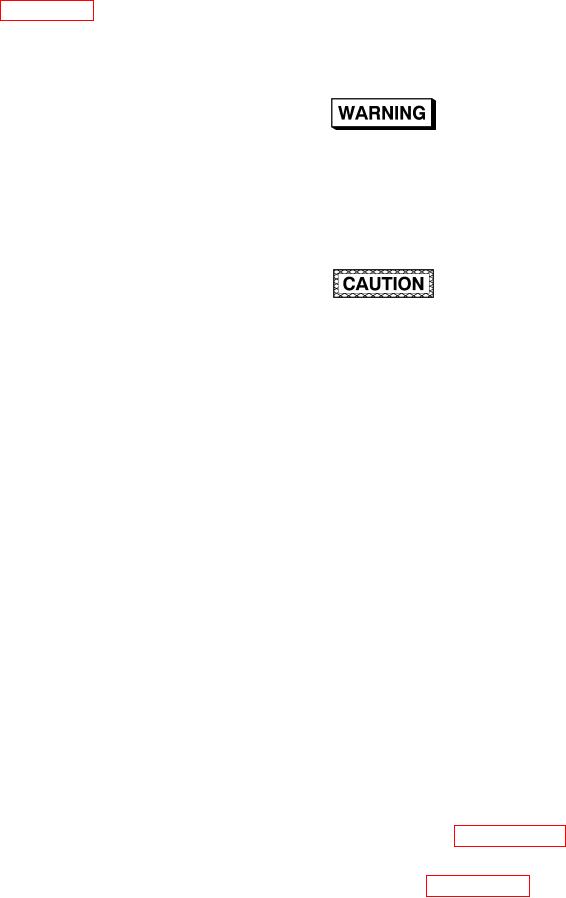
TM 1-1500-204-23-11
(a) Create a template of the repair plies
(i)
Apply sealant tape inside the perimeter
according to paragraph 5-6f.
of the bagging ilm. Leave the backing
paper on the sealant tape.
NOTE
(j)
Place a vacuum port base on the 5 inch
Selvage edge is only included for maintaining
square of breather material.
the correct warp direction during the layout
process, it should never be included in a
repair ply itself.
(b) Determine the required number of plies,
Resins, accelerators, and potting compounds
ply orientations, and fabric material from
are toxic to the skin, eyes, and respiratory
the system speciic technical manual.
tract. Prevent eye and skin contact by wearing
Cut one ply of composite fabric (car-
goggles and gloves. Perform all mixing in a
bon, glass), large enough so enough
well-ventilated area. If resin contacts the skin,
layers of material can be cut out with
wash immediately with soap and water. Do
the template created in step (a). Includ-
not use solvents to remove resin from skin.
ing warp tracers (if applicable) or leav-
ing the selvage edge on the fabric mate-
rial cut for this step will aid in aligning
the templates later in this procedure. If
Reduced strength will result if the incorrect
the repair involves more than six plies of
mix ratio is used, if an excessive amount of
material, you may divide the number of
air is introduced into the resin during mixing,
plies into groups and repeat this proce-
or if mixing is inadequate and may result in
dure for each group; this will minimize
loss of structural integrity.
waste and provide ease of handling.
Apply pressure to lay-up within the pot life
(c) Measure and record the total square
of the resin. For ambient temperatures in
footage of the dry fabric.
excess of 90 F, decrease this time by 50%.
An unsatisfactory repair will result if the resin
(d) Cut a sheet of release or vacuum bag
gels before adequate pressure is applied.
ilm big enough to fold over and fully
cover the fabric. It must be at least 6
Select and prepare all necessary vacuum bag
inches larger than the dry fabric on each
materials prior to mixing resin. If multiple
side
sheets are to be impregnated, the resin will
need to be mixed in a separate cup for each
(e) Fold the non-porous ilm in half and
sheet to ensure the correct amount of resin
crease the fold to locate a centerline.
is applied to each sheet.
Once the centerline is located unfold the
ilm to its full size.
NOTE
Mixing resin and fabric impregnation must be
(f)
Place the fabric in the center of one half
done in a controlled environment. Material
of the non-porous ilm.
has a limited pot life. Mix only the amount
of material that can be used within the pot
(g) Place a strip of 1 inch wide (minimum)
life listed by the manufacturer.
breather material around the perimeter
of and just touching the repair fabric.
(k) Determine the amount of laminating
Overlap the breather material at the cor-
resin that will be needed. Refer to the
ners to ensure a continuous air path to
system speciic technical manual for
the vacuum ports. Tape the corners of
the amount and type of resin to use. If
the breather.
no resin amount is speciied, use the
(h) Place an additional piece of breather
amount speciied in paragraph 6-17.
material for the vacuum port; this piece
Use resin manufacturer s recommen-
should be at least 5 inches square and
dations for mixing. Prepare the vacuum
must overlap the perimeter breather.
bag according to paragraph 6-18 prior
In the event that resin is drawn into
to mixing resin.
the breather, this extra large square of
(l)
Pour the resin onto the center of the fab-
material will help prevent the vacuum
ric; pour it into a single pool of resin
port from becoming clogged.
6-45

